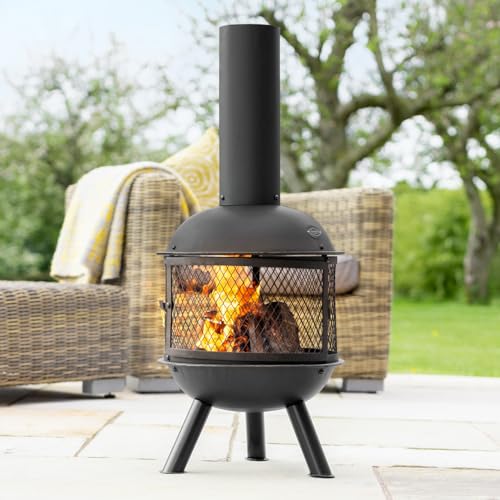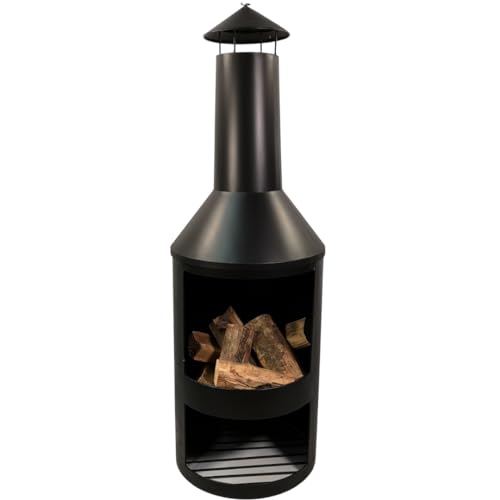Fire Pits & Chimineas Tools To Make Your Everyday Lifethe Only Fire Pi…
페이지 정보
작성자 Thelma 댓글 0건 조회 9회 작성일 24-10-24 21:50본문
 Chimineas Vs Fire Pits
Chimineas Vs Fire Pits Chimineas are similar to stoves with a potbelly, as they have an opening at the front where fuel can be stored and an attached chimney that directs smoke upward. They are available in a variety of materials, including clay or terracotta for the traditional appearance and iron or cast iron for durability.
Chimineas are similar to stoves with a potbelly, as they have an opening at the front where fuel can be stored and an attached chimney that directs smoke upward. They are available in a variety of materials, including clay or terracotta for the traditional appearance and iron or cast iron for durability.Models made of clay can be fragile and require careful handling while metal models are able to stand up to higher temperatures and rougher handling. Both add warmth and ambience to outdoor spaces.
Chimineas
Chimineas resemble fireplaces in a number of ways, but they have a more decorative look and are specifically designed for outdoor use. They are usually constructed of clay or terra cotta, and may be brightly decorated with themes inspired by Mexican culture. Modern chimineas tend to be made of materials such as aluminum and cast iron, which are more resistant to damage and breaking than traditional clay.
The chiminea, which was originally a potbellied fire, was developed in Mexico and the Western states. Although they are mostly used for entertainment they can be a stunning addition to any outdoor space and can be an attractive focal point to complement rustic decor. The long chimney of a chiminea may direct smoke upwards, keeping it out of the reach of people sitting around it. This is in contrast to fire pits that usually contain an open flame which can release sparks, embers, and other debris on the ground.
Chimineas as well as fire pits provide warmth to outdoor spaces, but they offer distinct advantages and requirements for maintenance. Personal aesthetic preferences play a big role in this decision, as a chiminea's ornate design can work well with a variety of different styles of gardens. A fire pit's sleek, minimalist design is suited to an array of outdoor settings.
The maintenance difference between chimineas versus fire pits is largely due the materials used. Terra clay, terra cotta and cast iron are more vulnerable to being damaged. Thus, chimineas need more frequent maintenance.
Both kinds of outdoor fireplaces are popular because they provide a warm and inviting area for family and friends to get together for drinks or dinners. A chiminea's protected and enclosed design makes it a better choice for more intimate groups and can be more efficient in warming the room. The chiminea's safety benefits come from the fact that sparks and embers that blaze off the fire are contained. Fire pits should be carefully placed to reduce this risk and be constantly monitored.
Fire pits
You might have to decide whether you want to add an achiminea or fire pits & chimineas pit when you are planning an outdoor space. Both options provide warmth and elegance to your patio or garden but they differ in terms of their design operation, as well as safety features. We'll help you choose the right solution for your space by comparing initial costs maintenance, fuel and more. We'll examine the heat output smoke, the safety and heat output of both.
A chiminea or chimenea is an open-air fireplace with an open chimney that can be used for cooking. They can be constructed from clay, metals like cast iron or steel, or cement or stone. They come in a variety of shapes sizes, shapes, and styles to match different styles of outdoor decor. They can be insulated for the user with a sense of security and a controlled flame. This reduces the risk of sparks and promotes safety.
Although chimineas are compatible with charcoal and wood, it is best to use seasoned or dried logs that have been kiln dried. Moisture wood creates more smoke and heats less efficiently. Chimineas also require a larger fire to keep them warm, which can result in a higher amount of smoke, however this can be reduced by proper air flow, the use of a log grate, and regular maintenance.
Fire pits can be constructed out of a variety of materials including steel, which is the most well-known due to its strength and affordability. Some fire pits can be moved around while others are permanent fixtures. They are typically erected in the ground or on a raised deck and come in a variety of shapes, sizes and finishes to complement a range of outdoor decors. They can be powered by gas, providing added convenience and control, or by charcoal and wood.
While they can be easier to maintain than chimineas but fire pits are considered more dangerous than Chimineas. Their open design permits more stray sparks, which can be a danger to pets and children. To avoid accidents, they should be placed away from flammable objects and kept under constant surveillance. They also produce a large amount of smoke and ash, which could make it uncomfortable for some.
Safety
Both chimineas, and fire pits can add warmth and awe to any outdoor space. However they also carry risks. Both are extremely hot, so you must be cautious when using them, especially when you are around children and animals. Both are suitable for surfaces that are susceptible to cracking when heated (see below). It is advisable to place a layer of bricks and stones under the fire pit. Both are prone to releasing large amounts of smoke, which could be an issue for those living in areas that are windy. The chiminea is less vulnerable to wind blowing embers and ash because the fire is contained within. However, the opening is only on one side and it is difficult to see the back, so it would be easy to leave a chiminea in a safe place in a windy location.
It is crucial to only use seasoned, dry and kiln-dried logs for all types of fireplaces because they burn better and produce less smoke. Avoid using flammable materials, such as paper, twigs and garbage, which can quickly ignite and cause a dangerous reaction.
Be aware of any local burn bans that may be in place. They could be caused by adverse weather conditions that combine with high emissions to increase levels of fine particulate matter pollution to dangerous levels. Breathing these harmful toxins can cause respiratory issues.
Keep a bucket of water or garden hose in case the fire gets out of control. Also, ensure that the area surrounding your fire pit is clear of branches, twigs, and leaves that could easily catch fire. It is also a good idea for you to keep an emergency kit near your fire pit in the event that someone is injured by sparks and smoke. With proper care both a chiminea and the fire pit will last a long time. A cast iron chiminea is a more durable option for your patio than clay or terracotta which are less durable and may crack in high temperatures.
Maintenance
If you don't maintain your chiminea grill or fire pit, in your backyard, it could cause serious dangers. If used improperly or situated too close to a home, shrubbery or other structures, it can lead to an fire in the house and cause severe injuries or damages. It is crucial to ensure that only natural materials like wood are burned and that no plastics, trash or liquid fuels are allowed to be employed. You should also check your local weather forecasts to comply with rules governing when you can burn. Finally, it is a good idea to keep a fire hose or extinguisher at hand in the event of emergency.
A chiminea, a traditional outdoor wood-burning fireplace, provides warmth and ambiance to patios and gardens. Chimineas come in a variety of styles and finishes. They are constructed from clay, metal, or cast iron. Many chimineas are decorated with an intricate, traditional design that brings a rustic feeling to outdoor spaces. Chimineas are also believed to be more eco-friendly than fire pits since they generate less smoke and particulate matter emissions.
Cleaning your chiminea on a regular basis will ensure it is in good condition. Start by cleaning out any ash and unburned wood from the grate. Then, you can build a small chiminea fire using little pieces of wood that can be used as a kindling. Let it burn for around an hour before carefully dowsing the flames with water until they are extinguished them completely. Then, wait for the chiminea to cool prior to making another fire with larger pieces of wood.
Chimineas can be a beautiful addition to your outdoor space, however they require more maintenance than fire pits. To avoid rust or other damages caused by the elements, they should be cleaned regularly. Additionally, chimineas can be very fragile and could crack or break if not handled with care.
Ultimately, the choice to go with a chiminea terracotta or fire pit depends on personal preferences and budget considerations. Both options have their benefits, but you should compare the initial cost as well as long-term costs before deciding which is the best option for your home. If you are seeking a long-lasting solution, you can consider a custom-built chiminea or a fire pit constructed of durable materials such as stone or steel that can withstand more frequent use and extreme weather conditions.
댓글목록
등록된 댓글이 없습니다.